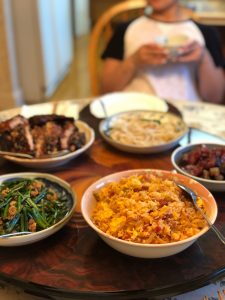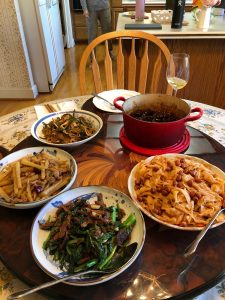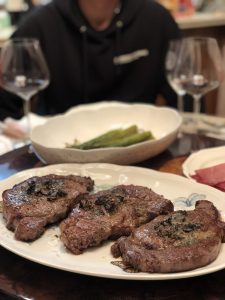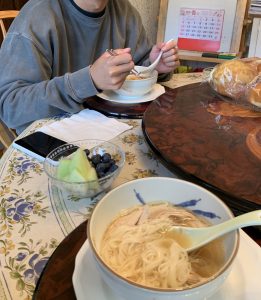Culinary Tourism of Italian and Chinese Cuisine: Is it Too Late to Turn Back?
Abstract: I took a chance on a new Netflix show to watch called, “The Chef’s Line,” which is a competitive cooking show that takes line-chefs from a top restaurant and everyday home cooks to battle out dishes from the home cook’s own ethnic cuisine. Judges with years of experience then critique the dish’s execution of authenticity, flavor, creativity, and texture. It was an interesting comparison between the tastes of home and professional culinary technique, which made me wonder if tradition and authenticity can truly be beaten and if not improved by chefs. However, as a viewer of the show I also became aware of my attraction to the pageantry of food in the world of cooking shows and docuseries. This paper explores the way the humans consider food as a spectacle (specifically via culinary tourism) and how globalized cuisines struggle to maintain and preserve the authenticity of its national culture through diaspora, economic growth, media and social conduct.
Food in its traditional sense was served as a medium to nourish the body and bring people together, but affluent modern-day societies are reassigning this initial purpose of food to nourish desires, feast the eyes, and distinguish people by class, race, and privilege. The heavy reliance on visuals in correlation with the rise in media makes it even easier to influence what consumers eat and ultimately prevails the human body’s natural intuitions such as the innate sensation of hunger. Although globalization has economic and political benefits on an international scale, it is detrimental to the survival of ethnic cultures, especially in the age of information and technology. Chinese and Italian are two of among the top globalized cuisines that have successfully gained an upper-hand leverage of influence through food, yet the countries also exemplify challenges of keeping the authenticity of their cultures and history alive. Therefore, with the commodification of culinary tourism, globalized cuisines cannot be, and are not, authentic cuisines. Is it too late for Italy and China to turn back?
Even though food is a commodity itself, the commodification of the aesthetic of food has given rise to a whole new industry – culinary tourism. The first-world luxury of culinary tourism and the constant accessibility to food prioritizes the innovations for visuals and tastes at the cost of a dish’s cultural token. The dangers of this process called deterritorialization, “or the delinking of cuisine from place,” is that food can inherently encourage stereotypes and close-mindedness towards traditions and rituals that have been a part of a national identity for generations (Farrer 9). The consideration of culinary tourism as a luxury derives from the idea that food is sought out for the experience rather than an element necessary for survival. The purpose of food has been redefined to validate the trendy lifestyles of upper and upper-middle class consumers. Whether that means paying a visit to Italy or China for food and drinks, or simply going to a restaurant in a new city or small town, culinary tourism has opened up opportunities to travel the world without exactly leaving a country, all thanks to the clever engineering of urban foodscapes. For those with financial capital that can afford to participate in culinary tourism, “consuming ethnically coded food is more than a cultural activity closely related with kinship and ritual; it is also a long-standing material practice in global commerce and exchange” (Mannur 28). As a result, acquiring cultural capital has become just as much of a sign of wealth and prosperity as financial capital.
The first and most obvious identifier of wealth and lifestyle in [Chinese and Italian] cuisine is the difference in setting of casual dining and fine-dining. With this, people start to make criteria for higher and lower tastes, as “taste for fine cuisine is an organizing practice that makes distinctions not only among dishes and their flavors but also among the people who make and consume them” (Farrer 5). Italian cuisine’s association with fine-dining comes from use of highly esteemed chefs creating art pieces whereas many Chinese take-out restaurants make quick food that is casually meant to eat at one’s own home. Chinese takeout food is “bland, cheap, and greasy,” often a product of a family-run business instead of trained professionals (Wu 39). In fact, chef’s raise more concerns about the jeopardies of accurately depicting the appearance of their food because “the photographs impinge on the artistic value of the food. Amateur photos taken in dim restaurant lighting on smartphones fail to capture the artistry of the food as intended by the chef” (McDonnell 244). Regardless of dining experience and setting, one of the handful similarities between Italian and Chinese cuisine is that they fit into the global mentality of capitalism because most of its food is convenient in their own unique ways, especially when it comes to the cereal-based foods. Cereal based foods are also the most sensitive to demand and selection pressures because of its convenience and malleability to be paired with many flavors and ingredients regardless of its authenticity. Preparing pizza or pasta in the house seems like an attainable task, as dried pasta, sauces, cheese, and pre-made dough are easily found in the aisles of any grocery store. Unlike Italian food, these certain spices and ingredients for Chinese recipes require a separate trip to an Asian food market, making homemade Chinese dishes not so convenient for non-Chinese cooks. “There exists a demarcation between those who eat for sustenance, and those who eat for something more – whose class position puts them beyond the exigencies of calories for cost, thereby enabling expressions of alternative logics imbricated with cultural tastes” (McDonnell 264). In the realm of fast-food, Chinese take-out is meant for sustenance as it never fails to deliver on a rainy or snowy day, holiday, or late-night snack. Chinese take-out also does not require much dining furniture due to the user-friendly containers and plastic utensils it comes with. Meanwhile, pizza and pasta require an extra set of plates and are not as easily transportable or accessible 365 days a year from restaurants. Authentic taste is believed to be able to derive from both casual and fine-dining settings, but culinary tourism has actually ruined the chances of genuine authenticity as a characteristic for either atmospheric setting.
Culinary tourism is intensified via social media platforms and blogs where aestheticism is appreciated and endless records of food are kept. Whether it is through writing, photos, or videos, media has a significant role in globalization as “transmitters of instrumental symbolizations—in all the dimensions in which globalization proceeds” (Kuang 70). Along with this new approach to a culinary gaze comes the term “foodie,” which is any person who has a love for eating, publicizing the experience of, and trying new ones, too. A foodie’s participation in the culinary media realm shape and give rise to globalized cuisines, encouraging voyeurism and degrade the attractiveness of home food production (McDonnell 242). Correspondingly, there becomes is an increased pressure for restaurant-owners and chefs to constantly evolve dishes that cater to this up-and-coming generation of food connoisseurs that will, in essence, publicize and criticize the food and restaurant for free. While some foodies and tourists are attracted to the idea of trying many styles of familiar dishes, others look for new exotic flavors and composition. Unfortunately, the concerns to make food desirable and edible for a global audience still largely dilutes the meaning of authenticity.
When it comes to food, the definition of authentic can mean anywhere from the environment, the people, ingredients, flavor, recipe, and even the technique. But out of all of these conditions, authenticity most often associates itself with the concept of home. However, the continuous diaspora of immigrants and migrants inevitably impacts the authenticity of many tastes and cultures as they make themselves at home in new regions outside of their place of origin. Cultural exchange can occur over communication or trade, which makes food vulnerable to such external influences that can alter recipes, techniques, ingredients, and introductions to new flavors. Italy and China happen to have deep histories with much geographical diversity that also face the challenge of their own regional influences, especially pasta. (Italy’s Culinary Heritage 8). However, immigrants embrace the burden of bringing the most authentic forms of themselves under specific boundaries when it comes to culinary tourism. It is no easy task to introduce anything unfamiliar, foreign, or exotic when it comes to food practices without any negative connotations that derive from stereotypes and cultural biases. Unfortunately, Italy and China already have contrasting reputations that are in place – romantic and exotic – and face different obstacles when it comes to meeting global spectators’ expectations.
The globalization of cuisines means it has been generalized to embody the perception of the home-country; advertising the good, testifying the bad, and hiding the ugly. This is where media is both a helpful and hurtful tool when it comes to establishing a national image. Although some photos and videos can be set up to prejudicial information, others act as a very transparent lens that give a firsthand look at the culture and lives of native people. The problem with this is that like many countries, some regions are more developed than others. But media has the scary ability to twist reality and words to exhibit any type of visual evidence in support of any sense of barbarity, immediately putting one’s own culture superior to the other as an excuse to form a valid, but possibly incorrect, opinion. From personal observation, media and entertainment in America, associates Italian food with fine-dining, romance, familiarity, and professionally made. Contrastingly, Chinese food is synonymous with take-out, cheap, exotic, and family-owned and operated. It is important to distinguish the differences between the familiar and the exotic as part of the presentations for Italian and Chinese cuisine. Though many of these characteristic traits are used as methods to further promote culinary tourism, the immigrants are, in essence, accepting their new identities that foreigners have established for them to assimilate themselves with. Therefore, not only does globalization drag out the lineage of food away from the country of descent but also the people. Regional dishes “are living records of the way in which a society lives, thinks, and feels,” which makes food a very central aspect towards the understanding of distant culture (“Italy’s Culinary Heritage” 8). As globalization and the popularity of culinary tourism grows, so does the fabrication of foodstuffs and the loss of historical records and tradition, slimming the chances of recognizing pure authenticity.
The demands for culinary tourism of any globalized cuisine is made possible in almost every major city in the world due to ethnic enclaves. The irony of globalization is that it disassociates the native people farther out from home and attracts foreign people in. It is a common misconception that the best place to get authentic food is the country itself of that particular cuisine because culinary tourism around the world is synthetically fashioned to any newcomers. The same then applies to ethnic enclaves that were once sources for some of the most authentic versions of food one could get outside of the home-country since the first ethnic businesses to open are usually food related (grocery stores, butchers, and restaurants) for the sake of recent immigrants to have access to ingredients native to their country and prepare dishes from home (Il Ventre Di Torino 95). Constant language barriers and cultural pressures for immigrants over an elongated amount of time led to the production of their own jobs and entrepreneurial endeavors, which ultimately formed communities such as Little Italy and Chinatown. These small businesses “offer employment opportunities for newly arrived migrants, who might not have language skills to find jobs in the host country” (Il Ventre Di Torino 95). Interestingly, the labels of these two ethnic enclaves seem to reflect the same perceptions of Italy and China as previously mentioned. “The establishment of food-related businesses [usually] indicates that migrant communities are putting down roots,” but it seems that Italy’s so-called roots were given more room to grow than China’s (Il Ventre Di Torino 96). Italy has been given the title of a little-country whereas vast China is confined to a town. This observation ties back to the stigmatization of China’s association with the exotic and dirty and Italy’s style of familiarity and cleanliness as a branch of European culture from a Eurocentric standpoint. A more in-depth observation for the so-called confinement of Chinatowns is that “in a restaurant kitchen that is largely mono-ethnic or where entry is closed by religious, linguistic, or other barriers, the culture of that kitchen will spread in a more limited fashion” (Farrer 14). But when it comes to Chinese food, the preparation may require some extra knowledge, skills, and tools to execute a noodle dish that simply cannot be imitated by any restaurant.
Due to culinary tourism, ethnic enclaves are not always the best representations of their home countries. In fact, it is quite opposite, as ethnic enclaves have become a spectacle rather than an embodiment of so-called true culture. For Chinatowns, the evidence of this is embedded in the elaborate gates of Chinatown, splashes of red and names such as golden, panda, wok, lucky, palace, jade, dragon, and garden are displayed to capture the crux of China’s civilizations. On the other hand, Little Italys around the world are also a spectacle with the air filled with the voices of loud Italian accents, open kitchens that showcase pizza dough being tossed up, and the Italian flag as the color scheme for many shops. As much as the food and culture in both Chinese and Italian cuisines have undergone many changes, the common theme across all ethnic enclaves is that they are frozen in time. There are no imperial gates in modern China or fast-pizza joints on every block in Italy, but these are the consequences of rebranding or traveling cuisines, which “are usually still identified through place names and are re-grounded in new settings, through indigenization, rebranding, and other processes of adapting to local circumstances” (Farrer 1). As a brand, Littly Italys and Chinatowns go untouched and are never elaborately updated amongst the rest of the urban cityscape they are located in, perhaps because it is the only way to keep the essence of the culture visual to the eye. Again, it all comes back to the notion of the heavy reliance of aestheticism in modern-day life. This is at no fault of the immigrant families because it is their role as business-owners to tailor to the demands of consumers. The diminishing sense of authenticity is largely at the fault of society and the consumers for the lack of knowledge in cultural relativism and bias.
Unfortunately, culinary tourism and the efforts to be widely accepted even effects the home-countries themselves. The Porta Palazzo, a multiethnic market environment located right in Italy, just recently experienced a change in the 2000’s. Author Rachel Black recalls her second visit to the market without a couple who sold live chickens. It turns out that during renovations, the administration prevented the long-time vendors from returning because of public health concerns that derive from live poultry. Another fellow vendor “noted that this was a huge loss to the market in terms of authenticity” (Il Ventre Di Torino 115). Even ethnic enclaves within Italy itself has lost a sense of its own domestic authenticity, which is the harsh reality that culinary tourism dawns upon many ethnic communities. One of the many dilemmas attached to indigenization is the association with Asia and dogmeat, where the traditional and ethnic practice is criminalized in the western world especially, in the United States. It is one example of a part of China’s select regional cuisines that cannot be embraced, as dogmeat is used as an excuse to humorize Asian culture and evidence to further support the claim of such primitive behavior (Wu 42). This stems from the cultural bias of American families forming close relationships with their pet dogs, and the failure to understand the medicinal practice of eating dogmeat that Chinese people for thousands of years have benefitted from. There is undoubtedly a hypocrisy and cultural ignorance towards Chinese cuisine’s traditional medicinal usages, as the iconic dish chop suey that usually incorporates recognizable meats, “derives from the Chinese phrase zasui, which refers to a miscellany of chicken livers, gizzards, fungi, bamboo shoots, pig tripe, and bean sprouts in a brown sauce” (Chan 178). As a result, cultures must willingly be rebranded under a specific list of conditions that are conventional to a widely Eurocentric audience.
However, countries have utilized the soft power of food by enacting policies and organizations not only to increase tourism, but to encourage agricultural exports and express cultural diplomacy (Farrer 15). The overall objective of government involvement is to establish a set of conditions that becomes nationally, and later globally, accepted for a recognizable identity under their own terms. Therefore, culinary soft power can be utilized by “local, regional, or national governments to promote and sustain culinary styles or traditions that are meant to be representative of a nation” (Assmann 1). In this case, food is a great tool to infiltrate the lives of others and provide a learning experience, not just a dining experience. Italy has done this by establishing the first annual World Pasta Day on October 25, 2006 mutually around the same time the Porta Palazzo was making its adjustments (“The Truth About Pasta” 25). The global celebration of pasta on this day is also a moment to educate the world about pasta’s cultural significance and honors Italy as its birthplace. China has taken the direct-route of media and took a federal investment on a state-run food docuseries called, A Bite of China, to showcase stories of the connections people have with food, the diversity the country’s true regional cuisines, and the elaborate preparations real Chinese food requires to counter the conventions of general ts’s chicken and lo-mein (Kuang 69). For Italy, the country makes efforts to overcome the stigmatization of the unhealthy attributes of pasta whereas China broadcasts different regions of China and reflects on its national history to highlight the details of “the country’s foodscape in terms of its discursively constructed history, culture, and materiality (Kuang 69). By backing up knowledge with factual statements and evidence, nations intend to transform the misinterpretations or misunderstandings behind many of the stereotypes that impact one’s experiences from any predispositions.
It is worth recognizing the industrialization of food as an experience, because the epidemic of culinary tourism has undoubtedly affected every globalized cuisine’s chance in the world to re-trace the roots of its own past in the search for authenticity. With the multiplicity of skewed impressions and records on food experience through the parallel growth in media, it is very confusing for the consumer to understand a strict definition for authentic Italian and Chinese cuisine. However, food is still revered as a part of daily life, which means an opportunity for nations to perpetually educate and familiarize themselves through food every day. So, to answer my question earlier – yes – it is indeed too late for Italy and China to turn back from globalization and revive a traditional authentic identity. On the bright side, there is a promising future for countries such as Italy and China because globalization is an opportunity to redefine a nation’s identity and reputation to shape a whole new meaning of what is authentic. By enforcing the establishment of national cuisine and utilizing the power behind food, it is time for new traditions to take place.
Works Cited
Assmann, Stephanie. “Global Engagement for Local and Indigenous Tastes: Culinary Globalization in East Asia.” Gastronomica: The Journal of Critical Food Studies, vol. 17, no. 3, 2017, pp. 1–3., doi:10.1525/gfc.2017.17.3.1.
Farrer, James. “Traveling Cuisines In and Out of Asia: Toward a Framework for Studying Culinary Globalization.” The Globalization of Asian Cuisines: Transnational Networks and Culinary Contact Zones, Palgrave Macmillan, 2015, pp. 1–19.
“Il Ventre Di Torino: Migration and Food.” Porta Palazzo: The Anthropology of an Italian Market, by Rachel E. Black, University of Pennsylvania Press, 2012, pp. 93–118.
“Italy’s Culinary Heritage.” The Classic Italian Cookbook, by Julia Della Croce, Dorling Kindersley, 2000, pp. 8–17.
Kuang, Lanlan. “China’s Emerging Food Media: Promoting Culinary Heritage in the Global Age.” Gastronomica: The Journal of Critical Food Studies, vol. 17, no. 3, 2017, pp. 68–81., doi:10.1525/gfc.2017.17.3.68.
Mannur, A. “Culinary Nostalgia: Authenticity, Nationalism, and Diaspora.” MELUS: Multi-Ethnic Literature of the United States, vol. 32, no. 4, 2007, pp. 11–31., doi:10.1093/melus/32.4.11.
McDonnell, Erin Metz. “Food Porn: The Conspicuous Consumption of Food in the Age of Digital Reproduction.” Food, Media and Contemporary Culture: the Edible Image, by Peri Bradley, Palgrave Macmillan, 2016, pp. 239–264.
The Truth About Pasta.” The Truth About Pasta, Oldways Preservation Trust , 2006, internationalpasta.org/index.aspx?id=47.



 There were harmonies amongst other cuisines as well, as lunch and dinner involved more casual meals such as pasta or steak. In fact, Alex even mentioned that “wooden placemats are made in Italy that we got during a family trip” without even knowing the background information about this class! A really interesting observation between the lazy susan and placemats – a mix of western and asian cultures.
There were harmonies amongst other cuisines as well, as lunch and dinner involved more casual meals such as pasta or steak. In fact, Alex even mentioned that “wooden placemats are made in Italy that we got during a family trip” without even knowing the background information about this class! A really interesting observation between the lazy susan and placemats – a mix of western and asian cultures.




